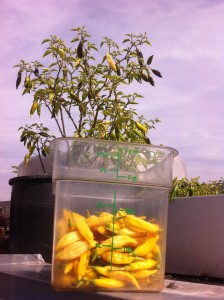Lemon Drop harvest from 4 plants. Two quarts plus plenty left to ripen.
My hat’s off to William Woys Weaver, the food historian and heirloom gardener (http://williamwoysweaver.com/biography/) whose 2006 Mother Earth News article on Lemon Drop peppers (http://www.motherearthnews.com/organic-gardening/aji-limo-zmaz06fmzwar.aspx?PageId=2) has answered questions I explicitly or implicitly posed in my last post (http://www.urban-ag-solutions.com/while-other-peppers-flop-this-one-still-drops/). And please give yourself a pat on the back if you actually clicked on all those references. Here are some of the nuggets o’ wisdom I gleaned from his article.
First of all Lemon Drop is a corruption of Aji Limo, basically translated as Pepper of Lima, which was probably bent by some partial hearing (my conjecture, not Weaver’s) into Aji Limon, which then means Lemon Pepper and thus is a short hop away from the more poetic Lemon Drop. The fact that it has citrusy notes and bright yellow color probably made the lemon reference inevitable.
Being a Capsicum baccatum means that it is Andean in origin and therefore adapted to cooler temperatures. This fact is reinforced by my experience in witnessing it delivering the goods even as cold nights come on. Woys Weaver has even more facts on the matter: “The baccatums also are extremely frost-tolerant, so it is easy to extend their growing season well beyond that of other peppers. In fact, the ‘Aji Límo’ plants in my garden grow well until the temperature drops to about 25 degrees, and even after that, their woody stems can be pruned, dug up and brought indoors for overwintering.”
I am going to research all of this more, but I’m very excited by the prospects of cold-adapted peppers. At the very least, they offer a reliable source of heat as the cold weather comes on…as in, pop one of these in your mouth on a cool day and you’ll begin sweating profusely like it was summer and, at least for a few minutes, the chill air will be the farthest thing from your mind!

